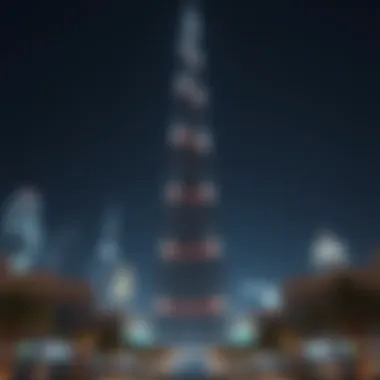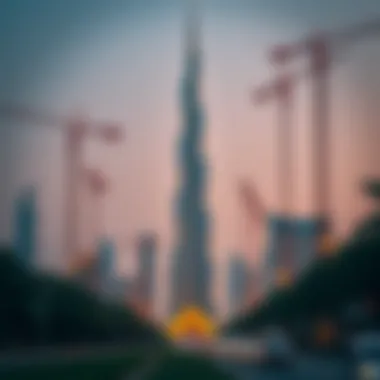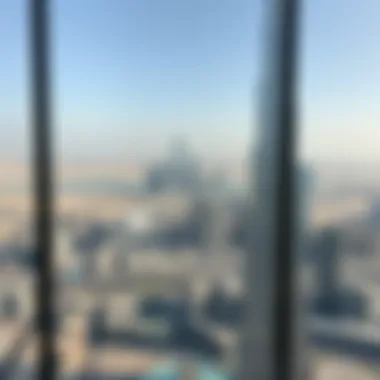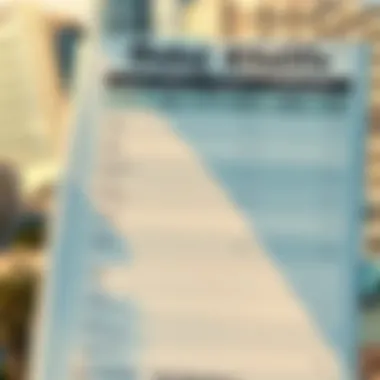Exploring Burj Khalifa: Ticket Deals and Visitor Insights


Intro
The Burj Khalifa stands as a remarkable testament to human ingenuity and architectural prowess. Towering at an astounding height, this iconic structure is not just a building but a symbol of Dubai's aspirations and growth. Visitors flock to experience breathtaking panoramic views of the city from its observation decks, while investors eye its strategic position within the bustling heart of downtown for real estate opportunities.
Among the many offerings available, the ticket priced at 51 AED is particularly noteworthy, drawing attention for both its affordability and the experience it promises. With a mix of historical context, promotional strategies, and comparison to other Dubai attractions, this article aims to be a beacon for potential visitors and investors alike.
Now, let’s navigate through the bustling landscape of ticket offers and how they align with Dubai's tourism goals, alongside potential investment opportunities stemming from this global landmark.
Foreword to the Burj Khalifa
The Burj Khalifa stands as more than just an architectural marvel; it represents a blend of ambition, engineering prowess, and cultural symbolism. Importance of the Burj Khalifa extends beyond its impressive height of 828 meters; it plays a crucial role in Dubai's identity and its global positioning as a leading tourist destination. The discussions around ticket offers, such as the enticing fifty-one AED special, connect not just to the experience of visiting but also to broader themes of investment, tourism trends, and social dynamics in contemporary Dubai.
Historical Context
The inception of the Burj Khalifa traces back to early 2000s when Dubai aimed to transition from a trade hub to a global city. Construction commenced in 2004 and culminated in its official opening in January 2010, coinciding with heightened ambitions for tourism and economic diversification. The project, developed by Emaar Properties, showcased not only architectural innovation but also the potential for transforming a desert landscape into a bustling urban area. As an emblem of Middle Eastern development, its height surpassed the Taipei 101, and this leap was an assertion of Dubai's narrative on the world stage.
The Burj Khalifa’s historical significance is intertwined with narratives of resilience and modernization, which attract tourists and investors alike. Historical insights reveal its role in attracting attention not just for aesthetics, but also as a point of reference for ambitious real estate projects across the region.
Architectural Significance
Architecturally, the Burj Khalifa is an exemplar of modern design philosophies, employing a mixture of traditional Islamic motifs melded with cutting-edge technology. Designed by the architectural firm Skidmore, Owings & Merrill, the structure features a unique triple-lobed footprint inspired by the Hymenocallis flower, allowing inherent stability against wind forces—the taller the building, the more critical this becomes. The innovative design pushes engineering boundaries by utilizing a bundled tube system and high-strength concrete, making a compelling case study for both current and future architectural endeavors.
The building blends function with artistic vision, partly through its stunning lighting displays and the surrounding landscaped areas that contribute to a cohesive experience for visitors. The Burj Khalifa is not just a skyscraper but a vivid representation of what is possible when technology and creativity merge. Its architectural significance extends to lessons in urban planning and environmental sustainability, teaching stakeholders about integrating modern infrastructure with ecological considerations.
"The Burj Khalifa isn’t merely a symbol of success; it is a testament to human ingenuity, shining brightly in the sprawling landscape of Dubai."
Understanding Ticket Pricing
Grasping the nuances of ticket pricing at the Burj Khalifa is vital, especially for investors and real estate enthusiasts. The pricing structure not only reflects the stature of the building but also plays a significant role in how visitors perceive value. As the world's tallest building, the Burj Khalifa has a unique place in the tourism market, and its ticket offers can provide insights into larger trends within Dubai's economy.
When considering ticket pricing, potential visitors must weigh the experience against the cost. The fifty-one AED offer is not just a steal; it's a strategic move designed to attract both tourists and locals alike. This price point is enticing but also serves a dual purpose: it boosts foot traffic and showcases the value of the high-rise experience without hitting too hard on the wallet.
Current Offers: Fifty-One AED
The current pricing at fifty-one AED is noteworthy, as it reflects a conscious effort to make the experience accessible to a broader audience. This promotional offer isn't just about drawing in numbers; it also encapsulates the experience of Dubai's charm and innovation. Visitors can ascend to levels that offer panoramic views of the cityscape, capturing snapshots that are Instagram-worthy.
"For many, a visit to the Burj Khalifa is a once-in-a-lifetime opportunity, and the pricing makes it possible for more people to enjoy this milestone."
Moreover, the ticket price offers quantifiable benefits. The simplicity of the offer allows visitors to budget accurately, making their travel plans straightforward. By offering such pricing, the Burj Khalifa aligns itself with broader marketing strategies aimed at promoting Dubai as a key tourist hub, enhancing brand visibility on a global scale.
Comparison with Other Attractions
When you stack up the Burj Khalifa's ticket pricing against other attractions in Dubai, it becomes clear that value is a significant selling point. For example, entry to the Dubai Aquarium and Underwater Zoo at The Dubai Mall is priced similarly, yet the experiences differ vastly. Likewise, a day at Wild Wadi Waterpark can run higher in cost without offering the same iconic views. This positioning serves well; it cultivates a competitive edge.


- Burj Khalifa: 51 AED for stunning views and city panorama.
- Dubai Aquarium: Prices start around 90 AED for basic entry.
- Wild Wadi Waterpark: Tickets can reach up to 250 AED, depending on season and age group.
This comparison demonstrates that while the Burj Khalifa may not be the cheapest attraction, what it offers makes it affordable relative to its unique experience. Access to one of the principal landmarks in the world for less than the price of a brief visit to a waterpark is a strong incentive for any traveler.
Trends in Pricing Over Time
Ticket pricing for the Burj Khalifa has gone through various transformations since its inauguration. Initially, prices were significantly higher, aligning more closely with the exclusivity of the experience. Over the years, there has been a noticeable decrease in some ticket prices, such as current promotional offers that attract visitors during less busy times.
Understanding these trends not only helps in grasping the current offers; it also informs investors and stakeholders about the shifts in market demand. Declining prices during off-peak seasons help drive traffic when it dips. It illustrates a flexibility to adapt to audience needs while also sustaining operational revenue.
- Initial Pricing: When first opened, tickets were pegged at around 100 AED.
- Major Adjustments: Over time, pricing began to shift, with different promotions and discounts popping up, particularly aimed at families and groups.
This evolution reflects a broader trend within the tourism industry in Dubai, where attractions must remain competitive. It reveals an adaptive approach aimed at maximizing visitors’ experiences while ensuring the attraction remains a pillar in the local economy.
The Visitor Experience
When it comes to the Burj Khalifa, the sheer scale and beauty of the structure are not the only points of interest. The visitor experience is paramount; it shapes how impressions are formed and determines the overall satisfaction of each guest. A well-rounded experience at the world’s tallest building can serve as a perfect encapsulation of what Dubai has to offer—luxury, modernity, and cultural richness. By showcasing the journey to the observation deck, the available amenities, and the vibrant cultural events, the encounter becomes far more than just a visit; it evolves into a memorable experience that resonates with every individual.
Journey to the Observation Deck
The journey to the observation deck is essential as it sets the stage for what’s to come. Starting from the moment you step foot in the Burj Khalifa, anticipation builds. Visitors are guided through a well-orchestrated path that includes displays of history and technological advancements that went into constructing the tower.
- The elevators themselves deserve a mention—they’re among the fastest in the world, whisking guests up with dizzying speed. The sense of ascension combined with soft music creates an atmosphere that heightens excitement.
- As you approach the observation deck, you’re greeted by panoramic views that are simply breathtaking. When you look down, the city seems to spread out infinitely beneath your feet. It's not merely about reaching a destination; it’s about savoring the thrilling ride upwards.
"The moment you step into the elevator, you're not just going up; you’re embarking on an experience of a lifetime."
Amenities and Services Available
Once visitors reach the observation deck, they will find that the amenities and services available are designed to enhance their experience. Comfort and convenience are at the forefront, ensuring that every guest can enjoy their time without any hitches. Key features include:
- Viewing platforms: Multiple vantage points are available for those eager to capture the perfect cityscape selfie. Descriptive signage adds context to the view, making the experience not only visual but educational.
- Dining options: Light snacks and beverages are available on the deck, allowing visitors to enjoy refreshments while gazing at the skyline. A pairing of fine dining and a top-tier view is a treat few can resist.
- Guided tours: For those who wish to delve deeper into the architectural marvel, guided tours provide a wealth of information. These sessions help make sense of what visitors might see from their lofty perch.
Cultural Events and Exhibitions
The Burj Khalifa isn't just a static attraction; it pulsates with life through cultural events and exhibitions. These events serve as a platform for celebrating both local and international artistry. Visitors can engage with:
- Art installations: Rotating exhibits showcase a myriad of works from various artists. Whether modern or traditional, these pieces add layers to the already complex identity of the building.
- Seasonal celebrations: During various times of the year, thematic events including light shows and festivals illuminate the atmosphere, showcasing Dubai’s diverse cultural tapestry.
- Workshops and lectures: Engaging the community, these programs provide insight into the artistic and architectural processes that define the region.
In essence, the visitor experience at the Burj Khalifa goes beyond just gazing at a magnificent structure. It's a comprehensive journey that encapsulates excitement, comfort, and cultural richness, all within the skies of Dubai.
Strategic Marketing of Burj Khalifa Tickets
Strategic marketing of Burj Khalifa tickets plays a pivotal role in drawing visitors from around the globe. The sheer height of the building alone is a massive attraction, but without effective marketing strategies, even the tallest structure might not generate the footfall it deserves. The approach involving unique ticket offers, like the fifty-one AED entry, demonstrates a keen awareness of potential visitors' preferences and economic factors. This ticket pricing strategy not only makes it possible for more people to enjoy the view from atop the world's tallest building but also cultivates a buzz, drawing attention to Dubai’s broader tourism sector.
Target Demographics for Offers


Understanding the target demographics is essential for the success of any marketing strategy, especially for landmark attractions like the Burj Khalifa. The marketing team likely aims to engage diverse groups:
- Tourists looking for unique experiences during their stay in Dubai.
- Local residents, offering them a chance to revisit their city from a different perspective.
- Business travelers who might blend leisure and work, making the trip a part of their itinerary.
Furthermore, social media campaigns can push ticket offers, capturing the attention of younger audiences who actively use platforms like Instagram and Facebook. Tailoring packages or discounts for families can attract those traveling with children, while special promotions during holiday seasons can lure in seasonal tourists.
Seasonal Promotions and Discounts
Seasonal promotions serve as a powerful tool in the marketing arsenal, allowing Burj Khalifa to remain competitive amidst numerous attractions in Dubai. By adjusting ticket prices according to holidays or festive periods, the strategy can effectively drive traffic during peak seasons. For example, during the Dubai Shopping Festival, an incentive like special group discounts or family packages can boost attendance, while balancing out quieter months during the off-season.
These promotions are typically well-advertised across various platforms, ensuring they get the attention they deserve. The short-term discounts encourage spontaneous visits, while advance booking discounts might attract those planning their excursions ahead of time. Having multiple pricing tiers, including options for guided tours, also adds value for guests, helping them decide based on their interests.
The Burj Khalifa and Real Estate Investment
The Burj Khalifa is not just a monumental feat of engineering; it is a catalyst in shaping the real estate landscape of Dubai. As the tallest building in the world, it stands as a landmark for both tourism and investment, making it a prime subject for the exploration of its influence on the local property market. Investors, realtors, and developers have their eyes on this icon, as its prominence tends to elevate surrounding property values and attract visitors, which in turn stimulates local economic growth.
Impact on Local Property Values
The presence of the Burj Khalifa plays a crucial role in ramping up property values in its vicinity. Properties in close proximity to prominent landmarks are often more desirable due to increased foot traffic and tourism. This has been evident in areas such as Downtown Dubai, where the skyline has transformed dramatically, yielding high-demand real estate opportunities.
- Increased Demand: Buyers and renters are keen to have a view of the Burj Khalifa. The more stunning the view, the higher the rental yield.
- Economic Ripple Effect: Businesses flocking to the area drive property prices upward, creating a buoyant property market.
- Attractive Developments: New projects in the vicinity often boast luxury amenities and premium pricing, further impacting the local market.
"A view of the Burj Khalifa isn’t just a perk; it’s a premium. Properties with this view often command higher prices and can appreciate more swiftly."
Opportunities for Investors
Investing around the Burj Khalifa offers appealing opportunities that can't be ignored. Investors can find various avenues to capitalize on the real estate potential associated with this monumental tower.
- Commercial Spaces: With the high volume of tourists year-round, commercial properties can provide lucrative returns, particularly in retail and hospitality sectors.
- Luxury Apartments: Developments offering a lifestyle experience draw affluent clientele, especially expatriates and international investors looking to invest in Dubai’s thriving market.
- Mixed-Use Developments: As the area thrives, mixed-use buildings that combine living, working, and entertainment spaces are becoming increasingly popular, offering diverse revenue streams.
The Burj Khalifa is a linchpin for investors eyeing Dubai’s real estate market. Understanding its impact provides critical insights into investment strategies, helping to navigate opportunities that emerge in the shadow of this global icon.
Navigating the Dubai Tourism Market
The Dubai tourism market presents a dynamic and rapidly evolving landscape, rich in opportunities and challenges. With the Burj Khalifa standing as a cornerstone of this vibrant sector, understanding the intricacies of this market is crucial for potential investors and stakeholders. The way tourism interlinks with developments in real estate is an area of significant interest, particularly for those looking to capitalize on the influx of visitors to Dubai.
Competitive Attractions
Dubai is not just about the Burj Khalifa; it’s a melting pot of attractions vying for a share of the tourism pie. Other noteworthy places include the Palm Jumeirah, with its luxury resorts and beach clubs, Dubai Mall, known for shopping experiences that are hard to beat, and the Dubai Aquarium, which offers unique underwater adventures.
- Palm Jumeirah: Home to Atlantis, The Palm, this man-made marvel lures tourists with its stunning architecture and aquatic adventures.
- Dubai Mall: Beyond shopping, this sprawling complex boasts an ice rink and the souk, making it a hotspot for families.
- Dubai Aquarium: A great attraction that allows visitors to see marine life up close and personal, often touted as a must-see.
The key to success in this competitive landscape lies not just in what attractions one offers, but also in how they market these experiences. Tickets priced competitively against similar attractions can help draw in the crowds. For instance, the Burj Khalifa’s fifty-one AED ticket is a strategic play that positions it as an accessible high-value experience.
As potential investors look to navigate this market, keeping an eye on these competitive dynamics becomes essential for assessing the viability of new projects.


Visitor Demographics
Understanding who visits the Burj Khalifa—and why—is essential for tailoring marketing strategies effectively. The demographics of visitors can shift based on time of year, events happening in Dubai, and even global travel trends.
- International Tourists: Many visitors come from Europe, Asia, and North America, with a significant boom during holiday seasons or global exhibitions.
- Local Residents: Expats residing in Dubai often frequent attractions like the Burj Khalifa, particularly for special occasions or to entertain guests.
- Business Travelers: Given Dubai's status as a global business hub, a notable portion of visitors is business-oriented, often seeking a blend of work and leisure during their stay.
The Burj Khalifa has become a symbol of aspiration and luxury, attracting visitors who wish to experience the heights of this iconic structure. By focusing on these demographics, stakeholders and investors can craft more effective marketing and engagement strategies, ensuring they cater to the evolving interests and patterns of potential visitors.
“In tourism, understanding your audience is like knowing the lay of the land; it’s indispensable for crafting experiences that resonate.”
For a deeper dive into Dubai’s tourism trends, resources such as Visit Dubai and Dubai Tourism provide ongoing data and insights.
Future Developments and Trends
In today’s fast-paced world, the concept of adaptability is essential, especially for iconic structures like the Burj Khalifa. Future developments and trends concerning this skyscraper highlight both the ongoing evolution of tourist experiences and the interplay of real estate investment in Dubai. This section digs deep into how the Burj Khalifa will continue to enhance its appeal and flourish as a hub for visitors and investors alike.
Expansion of Experiences at Burj Khalifa
As the tourism landscape continuously changes, so too must the offerings that the Burj Khalifa provides. The management aims to add fresh experiences that cater not only to tourists viewing the city from above but also to locals looking for unique engagements.
- Interactive Exhibits: Potential enhancements may include immersive galleries that showcase Dubai's transformative journey, utilizing augmented reality to deepen understanding and appreciation of the city’s history.
- Dining Experiences: An expansion of culinary options can attract food enthusiasts, including pop-up restaurants curated by renowned chefs that will offer menus inspired by regional cuisine.
- Seasonal Events: Imagine themed festivals or special events at the observation deck, perhaps synchronized with cultural calendars or major holidays, creating an unwavering draw for both residents and visiting travelers.
Such initiatives not only foster a renewed enthusiasm among repeat visitors but also support longer dwell times, thereby boosting on-site revenue along with the ticket sales.
Visitor Projections for the Next Decade
Looking ahead to the next decade, projections indicate an increase in both domestic and international visitors eager to explore Dubai’s architectural marvel. Factors contributing to this optimistic growth include:
- Global Recovery Post-Pandemic: As travel normalizes, the Burj Khalifa stands to capitalize on a surge of tourists rekindling their wanderlust.
- New Flight Routes: The introduction of increased direct flights to Dubai from various corners of the world could significantly enhance accessibility to the emirate.
- Promotional Campaigns: Through strategic marketing and partnerships with global travel agencies, reaching a wider audience will be easier.
- Cultural Tourism: With Dubai emphasizing its cultural heritage, the Burj Khalifa can act as a beacon, attracting visitors interested in experiencing the blend of tradition and modernity.
With these projections, experts anticipate a steady rise in visitor numbers, perhaps reaching fourteen million by 2030, establishing the Burj Khalifa not just as a landmark, but as an essential component of Dubai’s urban fabric.
Finale
The conclusion serves as the linchpin for our exploration into the Burj Khalifa's ticket offers and their implications in Dubai's broader tourism and real estate narrative. It not only ties together the multifaceted insights surrounding the ticket pricing but also provides necessary foresight into the evolving landscape of Dubai's real estate market.
Recap of Ticket Offer Insights
A deep dive into the various ticket offerings reveals strategic pricing that is both accessible and appealing to a diverse demographic. The unique pricing of fifty-one AED has attracted attention, transforming a trip to the Burj Khalifa from a luxury into a must-do experience for tourists and locals alike. This ticket strategy enhances visitor numbers, beckoning both international travelers and resident Dubai inhabitants to appreciate the building's grandeur. Promotional deals, seasonal discounts, and strategic marketing efforts have successfully created a buzz, making the world's tallest building more reachable than ever.
- The significance of fifty-one AED tickets highlights a push toward inclusivity in tourism.
- Targeted marketing campaigns identify and cater to key demographics, ultimately boosting visitor engagement.
- Seasonal promotions align with peak tourist traffic periods, maximizing potential ticket sales.
This approach has set a precedent for similar attractions in Dubai, positioning the Burj Khalifa not only as a sight to behold but also as a well-oiled operational strategy in the tourism sector.
Looking Ahead in Dubai's Real Estate Landscape
As we look forward, Dubai's real estate market appears robust, with the Burj Khalifa continuing to play a crucial role. The synergy between tourism and property investment is a pivotal focus for investors, realtors, and developers. Visitor momentum generated by attractive ticket pricing has already stirred interest in nearby real estate, impacting current property values positively. The following factors are crucial to observe:
- Property value trends: Proximity to attractions like the Burj Khalifa often boosts real estate prices, providing tangible investment opportunities.
- New developments: Upcoming projects around this iconic structure may further influence visitor engagement and investment potential.
- Sustainability considerations: As eco-consciousness grows, developments that prioritize sustainability are likely to see higher demand.
In summary, the Burj Khalifa stands as a powerful emblem in Dubai's tourism appeal and an essential component in the real estate dialogue. Monitoring ticket offers and visitor statistics will guide future predictions about the changing dynamics of property investment within this vibrant region. The interaction between attraction, visitor experience, and real estate will shape the landscape for years to come.















